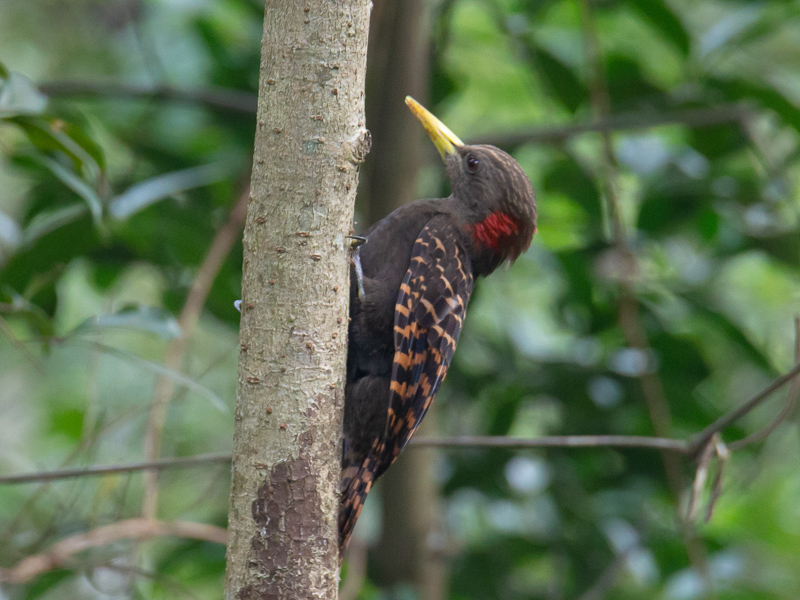Bay Woodpecker Blythipicus pyrrhotis 黃嘴栗啄木鳥
Category I. Uncommon but increasing resident in forest in the New Territories, first recorded in 1992.
IDENTIFICATION

Apr. 2015, KWOK Tsz Ki. Male.
26-30 cm. A medium-sized woodpecker with a brownish head, dark body and upperparts, the latter broadly barred orange-brown on the wings and tail. The large bill is a contrasting bright yellow and the male has a bright red patch on the nape.
VOCALISATIONS
Typically heard is the territorial call, a loud and far-carrying, decrescendo series of notes that become shorter in duration terminally. In addition, the contact call between individuals in a pair is a loud short repeated chatter. Both can be heard in this recording.
DISTRIBUTION & HABITAT PREFERENCE
A recent colonist, Bay Woodpecker is now a widespread albeit scarce resident in more mature broadleaf forest in the New Territories. Its main stronghold is the Tai Mo Shan massif and especially Tai Po Kau, where it was first found, but it now occurs at low densities in most forest blocks from Tai Lam and Tai Tong in the west to Lai Chi Wo and Sha Tau Kok in the northeast, Sai Kung East CP in the east and Ho Chung in the south. Recorded from 0.1% of squares in both the first (1993-96) breeding season atlas survey and (2001-05) winter atlas survey, these rose to 0.3% in the second (2016-19) breeding survey and 0.2% in the second (2016-19) winter survey.
It was first recorded away from Tai Po Kau in 2010 when one was observed at Shing Mun; this was the beginning of a marked increase in numbers and distribution. By 2015 ten individuals were recorded at six sites and by 2020 approximately 31 individuals were recorded at 21 sites. As the number of sites and number of birds has increased, it has become harder to be certain as to the totals; in addition, the call of Bay Woodpecker is far carrying and the birds themselves may be quite mobile.
OCCURRENCE
Bay Woodpecker was first recorded at Tai Po Kau on 9 April 1992 (Edge 1994) and it, or another, was recorded there on 17 April (a male), 12 May and 6 June 1993, and 22 and 24 August and 13 October (again a male) 1994 (Carey et al. 2001). It seems likely that all these observations referred to the same individual. It was not observed again until one was seen at the rather unusual location of Harbour Island (Pak Sha Chau Tau), more properly a peninsula, in Plover Cove Reservoir on 4 January 2003.
Subsequently, one was heard at Tai Po Kau on 30 November 2005, a male was seen there on 26 December 2006 and a male, presumably the same individual, was photographed there on 5 January 2007. A single bird was seen there on several occasions in January and August to November 2007 and again in 2008, with two noted together for the first time on 13 September 2008.
Bay Woodpecker is resident, but individuals move quite widely in the forest, presumably especially when not breeding. Evidence of Bay Woodpecker’s dispersive ability, and the presumed source of birds that colonised HK, is provided by one that was trapped at Mai Po on 18 September 2014, whilst the Harbour Island observation on 4 January 2003 is also suggestive of a bird that may have wandered to HK from the north. Bay Woodpecker is widespread in Guangdong and has been reported from Wutongshan, about 5km north of Robin’s Nest (eBird 2022).
BEHAVIOUR, FORAGING & DIET
Bay Woodpecker is found singly, in pairs and small, presumably family, parties, the largest group seen together being four birds. They are usually seen climbing on trunks or larger branches in typical woodpecker fashion or in flight; they are often rather shy, and many observations are of birds in flight having been flushed by the observer.
There appear to be no observations of diet from HK.
BREEDING
One photographed at Tai Po Kau on 5 January 2007 was at what appears to have been a recently excavated oval nest hole on the underside of the main trunk of a slightly leaning (c. 10 - 15° from vertical) tree. The first confirmation of breeding in HK was also at Tai Po Kau: adults were observed entering a nest hole containing at least one chick on 10 April 2016 and both adults were observed bringing food to a chick visible at the mouth of the nest hole on 11 April.
RANGE & SYSTEMATICS
Bay Woodpecker is found throughout southeast and east Asia from Nepal and northeast India south to the Malay peninsula and east through China to Sichuan, Hubei and Zhejiang (Winkler and Christie 2022, Liu and Chen 2020, eBird 2022).
There are five races, three of which occur in China: the nominate in Yunnan, B. p. sinensis from Guangxi and southeast China including HK, and B. p. hainanus in Hainan (Cheng 1987).
CONSERVATION STATUS
IUCN: Least Concern. Population trend decreasing.
Carey, G. J., M. L. Chalmers, D. A. Diskin, P. R. Kennerley, P. J. Leader, M. R. Leven, R. W. Lewthwaite, D. S. Melville, M. Turnbull and L. Young (2001). The Avifauna of Hong Kong. Hong Kong Bird Watching Society, Hong Kong.
Cheng, T. H. (1987). A Synopsis of the Avifauna of China. Science Press, Beijing.
Edge, J. S. R. (1994). Bay Woodpecker in Tai Po Kau: a new species for Hong Kong. Hong Kong Bird Report 1993: 121-122.
eBird. 2022. eBird: An online database of bird distribution and abundance [web application]. eBird, Cornell Lab of Ornithology, Ithaca, New York. Available: http://www.ebird.org. (Accessed: 18 July 2022).
Liu, Y. and S. H. Chen (eds) (2021). The CNG Field Guide to the Birds of China (in Chinese). Hunan Science and Technology Publication House, Changsha.
Winkler, H. and D. A. Christie (2020). Bay Woodpecker (Blythipicus pyrrhotis), version 1.0. In Birds of the World (J. del Hoyo, A. Elliott, J. Sargatal, D. A. Christie, and E. de Juana, Editors). Cornell Lab of Ornithology, Ithaca, NY, USA. https://doi.org/10.2173/bow.baywoo1.01

